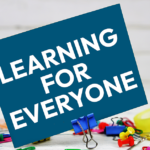We’ve all been there, clicking next through an online course while half-reading emails or planning dinner. As learning professionals, that’s the last thing we want for our learners. Designing and developing eLearning that truly engages takes more than sleek screens and cool interactions. It’s about creating experiences that connect, challenge, and stick.
So how do we move beyond passive modules and get people leaning into the learning? Let’s break down some practical, proven strategies for designing eLearning that grabs attention and keeps it.
Start with the Learner, Not the Content
Before diving into modules, interactions, or even objectives, take a step back. Who’s taking this course? What do they already know? What do they need to know, and what do they care about?
Creating learner personas can help. Think about a new hire in customer support vs. a tenured operations manager. Their context, time constraints, and motivations will differ wildly.
Also, consider the environment. Will they be taking this course on a desktop, tablet, or mobile phone? In a quiet office or a loud warehouse?
Pro tip: If your course isn’t optimized for how your learner will consume it, even great content can flop.
Make Interactivity Intentional (Not Just Clickable)
Not all interactions are created equal. Just because you’ve added a slider or drag-and-drop doesn’t mean it’s engaging. Intentional interactivity means embedding moments where the learner must think, not just click.
Scenario-based decision points, branching paths, and simulations force learners to pause, reflect, and apply knowledge. This drives deeper understanding.
Try this: Use Articulate Storyline to create realistic branching scenarios. Or use Synthesia to produce AI-generated video scenarios with on-screen presenters who guide learners through decisions in a conversational, human-like way. These tools help bring nuance and choice to dry topics like compliance or systems training, making learners feel like they’re part of a real-world situation instead of a quiz.
Tell a Story (Even in Corporate Training)
Storytelling isn’t just for TED Talks. Our brains are wired for narrative. A strong story can help learners retain information, relate emotionally, and apply knowledge.
Build a scenario around a relatable character. Give them a challenge. Add some tension. And then let the learner help resolve it.
Even for topics like cybersecurity, onboarding, or product knowledge, you can use a story to frame the “why” and draw learners in.
Example: A new hire follows a peer through their first 30 days on the job navigating challenges, learning systems, and making decisions. It’s onboarding, but with a human twist.
Use Visual and Audio Design Strategically
Design matters. But not just for aesthetics, it drives clarity and cognitive processing. Use visuals to support (not compete with) your message. Stick to consistent color palettes, readable fonts, and white space. Avoid overloading screens.
Audio is a powerful engagement tool when used well. A conversational voiceover can make learning feel more personal. Tools like WellSaid Labs or Audiate let you create high-quality narration without a recording booth.
Tip: Use short videos or animated explainers when showing processes or product demos. Save static visuals for conceptual information.
Break It Up: Chunking and Microlearning
Long modules? Forget it. Break your content into digestible chunks. Use clear headings, short paragraphs, and focused screens.
Even better, embrace microlearning. Think 3–5 minute bursts of learning that focus on a single idea or skill. Learners can complete them on the go and revisit them when needed.
Tools like 7taps make it easy to build mobile-friendly microlearning experiences.
Bonus: Microlearning is great for spaced learning. Helping combat the dreaded forgetting curve.
Give Learners Control and Feedback
Engagement increases when learners feel in control. Let them choose where to start. Offer optional deep dives. Add reflection questions to pause and think.
Feedback also plays a huge role. Go beyond “Correct!” or “Try Again.” Offer insight: “That answer makes sense, but here’s why it might not work in this situation.”
And if they make a mistake? Let them try again or see how a different choice could play out. That’s real learning.
Add Gamification Elements Thoughtfully
Gamification can absolutely increase engagement but only when it’s tied to meaningful outcomes. Progress bars? Great. Points and badges? Useful if tied to effort or results. Leaderboards? Maybe if the learners are motivated by competition.
The goal is to motivate, not manipulate. Use game mechanics to support autonomy, mastery, and progress.
Example: For product training, create scenario-based “missions” where learners earn new roles (e.g., Novice → Expert) as they demonstrate skills.
Test with Real Learners Before You Launch
User testing helps spot confusion, frustration, or content that falls flat. Have a small group of actual learners take the course before it goes live.
Watch them. Where do they pause? What do they skip? What feedback do they give? Then tweak based on how learners behave.
Build for Brains, Not Just Boxes
Developing eLearning for engagement doesn’t mean adding flashy features. It means designing with intention from how content is chunked, to how decisions are presented, to how learners feel throughout the experience.
Engagement isn’t a checkbox. It’s a mindset.
So next time you sit down to build a course, ask yourself: Would I want to take this? If not, keep iterating. The good news? You don’t have to figure it out alone.
Download Your Copy of Trends in Learning & Development: Insights from Learning Leaders
Ready to Work with Us?
Does your L&D team have more projects than people? TrainingPros has been named a Top 20 Staffing Company internationally by Training Industry, and recognized as a Smartchoice® Preferred Provider by Brandon Hall Group for 2025. We’re also proud to be named a Champion of Learning by the Association for Talent Development (ATD)—an international honor that reflects our dedication to excellence in corporate learning. These accolades underscore TrainingPros’ unwavering commitment to delivering high-quality, tailored training solutions.
If your projects need instructional designers, virtual classroom producers, facilitators, or other L&D consultants for your leadership development design projects, reach out to one of our industry-expert relationship managers today.
When you have more projects than people™, let TrainingPros find the right consultant to start your project with confidence. Schedule a consultation today.
- 1share
- LinkedIn0
- Twitter0
- Facebook0
- Love This1











